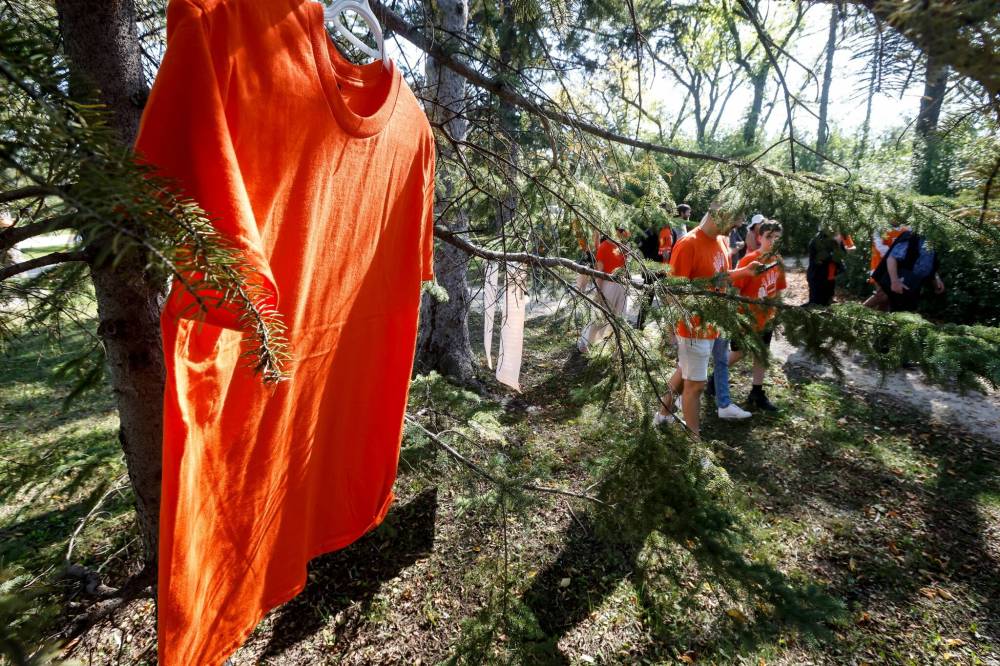New truths emerge among sea of orange
Advertisement
Read this article for free:
or
Already have an account? Log in here »
To continue reading, please subscribe:
Monthly Digital Subscription
$0 for the first 4 weeks*
- Enjoy unlimited reading on winnipegfreepress.com
- Read the E-Edition, our digital replica newspaper
- Access News Break, our award-winning app
- Play interactive puzzles
*No charge for 4 weeks then price increases to the regular rate of $19.00 plus GST every four weeks. Offer available to new and qualified returning subscribers only. Cancel any time.
Monthly Digital Subscription
$4.75/week*
- Enjoy unlimited reading on winnipegfreepress.com
- Read the E-Edition, our digital replica newspaper
- Access News Break, our award-winning app
- Play interactive puzzles
*Billed as $19 plus GST every four weeks. Cancel any time.
To continue reading, please subscribe:
Add Free Press access to your Brandon Sun subscription for only an additional
$1 for the first 4 weeks*
*Your next subscription payment will increase by $1.00 and you will be charged $16.99 plus GST for four weeks. After four weeks, your payment will increase to $23.99 plus GST every four weeks.
Read unlimited articles for free today:
or
Already have an account? Log in here »
No matter where you are, the path towards reconciliation between Indigenous Peoples and Canadians has been very turbulent over the past decade.
In the 10 years since the end of the Truth and Reconciliation Commission and the 94 calls to action, much attention has been placed on the progress — and lack thereof — towards changing the policies, practices and beliefs that embody principles of Indigenous inferiority and Canadian superiority.
The fact is: the Indian Act, the most racist law in Canadian history, is still here.

Virtually all of the Indigenous land stolen during the last 150 years remains stolen.
The majority of Indigenous communities are still mired in poverty, emergency situations and have citizens immersed in the child-welfare, health-care and justice systems of this country — with often lower than average life expectancies, educational results and economic options.
While the past 10 years have seen the most progressive federal government engagement on Indigenous issues in history — resulting in apologies, legal changes and nearly a dozen TRC calls to action completed and another 40 or so underway — the situation for most First Nations, Métis and Inuit peoples is generally the same as it was since the day the TRC completed its work in 2015.
Then, there’s September.
This is the fifth year that Sept. 30 marks the National Day for Truth and Reconciliation, a day when this country recognizes the tragic legacies of residential schools while committing to a path of building healthy relationships with Indigenous communities.
The day is a fulfillment of TRC call to action No. 80, which called “upon the federal government, in collaboration with Aboriginal Peoples, to establish, as a statutory holiday, a National Day for Truth and Reconciliation to honour survivors, their families, and communities, and ensure that public commemoration of the history and legacy of residential schools remains a vital component of the reconciliation process.”
Sept. 30 is the day that children like Phylis Webstad of the Stswecem’c Xgat’tem First Nation were taken away to school.
Given an orange shirt by her grandmother in order to always remember home, the shirt was taken away at St. Joseph Mission Residential School, leaving her with sadness and shame.
Now, hundreds of thousands wear an orange shirt in solidarity.
One day has now turned into a month of events.
This past week, I travelled to Ontario, Quebec and southern Manitoba, with my favourite stop being Erickson, a town of around 500 people 250 kilometres northwest of Winnipeg.
There, I spoke at a school assembly alongside a dozen adolescent men who sang in Ojibway, a young Métis girl who read a poem about murdered and missing Indigenous women and three local residential school survivors who shared their experiences with nearly 200 kids in the gym.
I was enraptured with how the huge group of students listened, enraptured by every single word of the survivors.
As I sat and listened, too, a boy sitting beside me told me one of the speakers was his grandmother.
“It must be hard to hear these stories from your kookum,” I said to him.
“I never heard these stories before,” he whispered to me.
“She probably didn’t want to upset you,” I said to him.
“It’s OK,” the boy told me, “I know she loves me.”
This is what I experienced at every event I attended this week — even as many truths were unveiled for the very first time.
None of it was easy to participate in, but in each event people who came from very different politics and perspectives shared tears, time, and food together.
In seas of orange, across cities and provinces, I was not the only one who had these experiences either.
On Saturday nearly 35,000 people from all walks of life came together at Princess Auto Stadium to watch the Winnipeg Blue Bombers defeat the Hamilton Tiger-Cats in the club’s annual Orange Shirt Day game.
I helped Bombers staff co-ordinate the event, which features the team wearing an Indigenized logo and orange T-shirts and warm-up jerseys, playing on a field with orange outlines, and performances from jiggers, pow-wow dancers, and the Arts for MB Indigenous choir, who sang the national anthem in Ojibway and Cree.
My personal highlight was the introduction of Blue Bombers defensive end Willie Jefferson, who pulled up his uniform to show the nearly 1,000 Indigenous kids flown in for the game he was wearing an orange shirt underneath.
It was something I’d never seen before.
Every year since the inception of the National Day for Truth and Reconciliation, I’ve said the same thing.
These are times and sights and moments we have never seen before.
With every year, despite the turbulence and slow-moving governments, Indigenous and Canadians are coming together in unexpected, unprecedented and remarkable ways.
So, keep putting on your orange shirts. The movement is beautiful.
niigaan.sinclair@freepress.mb.ca

Niigaan Sinclair is Anishinaabe and is a columnist at the Winnipeg Free Press.
Our newsroom depends on a growing audience of readers to power our journalism. If you are not a paid reader, please consider becoming a subscriber.
Our newsroom depends on its audience of readers to power our journalism. Thank you for your support.








